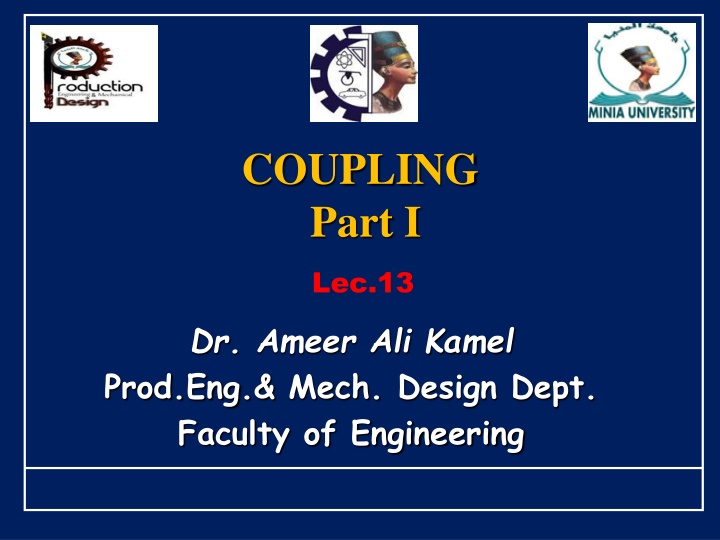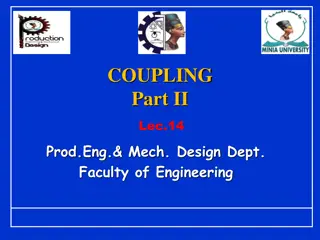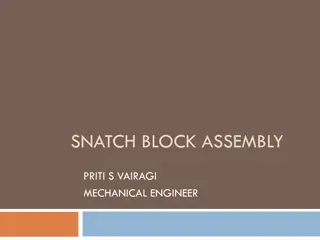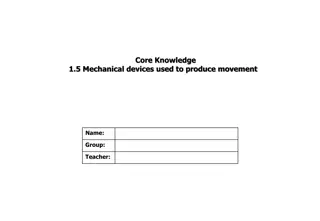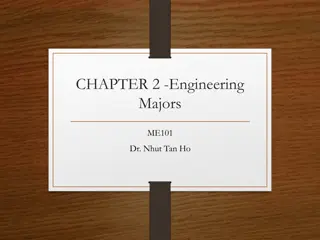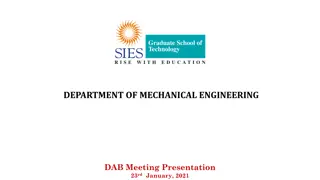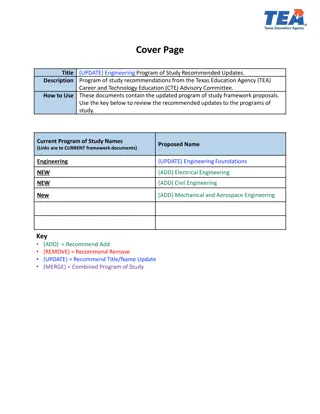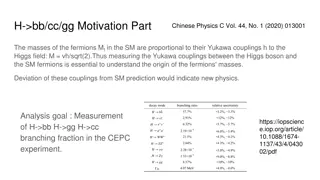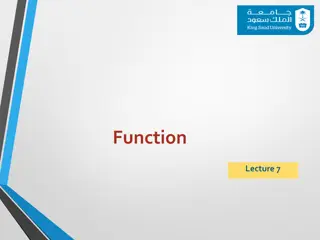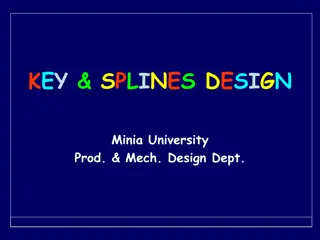Couplings in Mechanical Engineering: Types, Functions, and Design Considerations
Couplings play a crucial role in mechanical systems by connecting shafts, preventing misalignment, and transmitting power efficiently. Learn about the types of couplings, their functions, and key design considerations in this detailed lecture summary.
Download Presentation

Please find below an Image/Link to download the presentation.
The content on the website is provided AS IS for your information and personal use only. It may not be sold, licensed, or shared on other websites without obtaining consent from the author.If you encounter any issues during the download, it is possible that the publisher has removed the file from their server.
You are allowed to download the files provided on this website for personal or commercial use, subject to the condition that they are used lawfully. All files are the property of their respective owners.
The content on the website is provided AS IS for your information and personal use only. It may not be sold, licensed, or shared on other websites without obtaining consent from the author.
E N D
Presentation Transcript
COUPLING Part I Lec.13 Dr. Ameer Ali Kamel Prod.Eng.& Mech. Design Dept. Faculty of Engineering
INTRODUCTION Because of storage and transportation reasons, shafts can be found as row material in lengths up to 7m. Therefore, couplings take place if the required shaft length is greater than that of the available material. However, the purposes of using couplings can be summarized as follows: 1. Connect the shafts with the standardized units, which are manufactured separate such as electric motors, generators and clutches. 2. Prevent of misalignment of the long shafts and to increase the flexibility of the shafts.
3. Reduce or prevent the transmission of shock loads form one shaft to the other or to anther connected 2. Provide a certain protection against overloads. The shaft couplings should fulfill the following important requirements: 1. Easy to connect and disconnect. 2. Hold the connected shafts in a perfect alignment. 3. Transmit the full power of the shafts safely.
2. TYPES OF COUPLINGS: Couplings can be classified into the following mean types: (A) Rigid couplings: This type is used to connect two shafts, which are perfectly aligned. It can take the form of: - Sleeve or (muff) coupling. - Clamp or spilt-muff coupling. - Flange coupling. B) Flexible couplings: It is used to connect two shafts having both lateral and angular misalignment. The following types of flexible couplings are important:
- Bushed pin type coupling. - Universal coupling. - Oldham coupling. 3. SLEEVE COUPLINGS: It is the simplest type of rigid couplings, which made of cast iron. It consists of a hollow bush with an inner diameter equal to the external diameter of the shaft. A gib-head sunk key is used to connect the two shafts with their bush i.e. to transmit the power form one shaft to the other. L1 D d L Shaft 1 Shaft 2 Muff
L1 D d L Shaft 1 Shaft 2 Muff Consider : D = The outer side diameter of the sleeve d = The shaft diameter L = The length of the sleeve (L L1) T = The torque to be transmitted by the hollow bush s =The allowable shear stress of the sleeve. k= The allowable shear stress of the key. c= The allowable crushing stress of the key D = 2 d + 13 mm L = 3.5 d (1) (2)
D T 2 = = s ( D d ) 4 4 32 D d 4 4 T [ ] = = s 16 D d T D s ( 1 k ) & k 1 4 = = = = 16 D The design of the key must be carried out as illustrated by the design of sunk keys. Normally the key is designed as two parts so that the length of each can be considered as follows: L = L / 2 = 3.5 d / 2 i.e., L = 1.75 d
The strength of the key should be checked considering both of shearing and crushing. i.e. By considering the shearing stress of the key: d T L w = = s 2 t d T L = = s 2 2 It must be noticed that the depth of keyway in each the two shafts should be the same as the diameter of the two shafts is similar. If these conditions are not satisfied, the key will be bedded on one shaft while in the other it will be loose. To avoid this condition, the key will be made of two parts, which may be driven from the end of each shaft.
Example (1) Design a muff coupling to connect two shafts transmitting 50 h.p. at 120 r.p.m. The permissible shear stress and crushing stress for the shaft and key material are 300 and 800 kp/cm2. The material of the muff is cast iron with permissible shear stress of 150 kp/cm2. Assume that the maximum transmitted torque is 25% greater than the mean torque (mild steel). Solution P = 50 HP N = 120 r.p.m. s= 800 kp/cm2 c.I.= 300 kp/cm2 = 150 kp/cm2
= = P T P P 60 = = = = T 2 N 50 x 4500 = = = = Tmean 298 kp m . 120 x 2 Tmean= 29800 kp.cm Determination Of The Shaft Diameter d 16 T = = d 3 . I . C 16 29800 x 25 . 1 ( ) d3 = = = = 632 3 . x 300 d= = 58 . 8 mm
Design of Sleeve D = 2 d + 13 = 2 x 9.0 + 1.3 = 19.3 = 195 mm L = 3.5 d = 3.5 x 9 = 31.5 cm. Checking the Strength of The Muff 4 4 D d = = T [ ] s 16 D 16 TD = = 4 4 ( D d ) 16 x 37250 19 x 5 . = = 4 4 19 ( . 5 9 ) 2 = = 26 8 . kp / cm
Since the induced stress in the muff (26.8 kp/cm2) is less than the permissible shear stress of 150 kp/cm2, therefore the muff is safe. KEY DESIGN From the key tables, the width and thickness of a key for a shaft with 90 mm diameter are as follows: W = 28 mm = 2.8 cm & t = 16 mm = 1.6 cm The length of the key in each shaft = L L= L/2 = 31.5/2 = 15.75 cm Now, the check of the shear and crushing stress of the key can be carried out as follows:
For The Shearing Tmax=L w (d/2) 2 max T 2 x 37250 2 = = = = = = 187 kp 7 . / cm lwd 15 75 . x 2 8 . x 9 For The Crushing Tmax= L x (t/2) x cx (d/2) 4 x 37250 2 = = = = 657 kp / cm c 15 75 . x 1 6 . x 9 Since the induced shear and crushing stress are less than the permissible stresses, i.e. the design is safe.
4. CLAMP (COMPRESSIVE) COUPLINGS It is also known as split muff coupling. Here, muff (sleeve) is made of two equal halves, which are bolted together as shown in figure. Muff Stud (Bolt) Shaft(1) Shaft(2)
The following points should be considered: - The two halves are fixed together by either bolts or studs. - The muff material is usually cast iron - A single key is fitted directly in the keyways of both the shafts. - The number of bolts may be two, four or six. - The nuts are recessed into the bodies of the muff casting. - This type of couplings is used for heavy duty
This type of couplings has the advantage that the shafts need not be moved in assembling or disassembling of the coupling. The dimensions of this type can be determined from the following relations: 1. Determination of Shaft Diameter d : The calculation of the shaft diameter (d) can be done based on the maximum normal stress or the maximum shear stress theory according to the chose of the elastic failure theory. 2. Diameter Of The Muff or Sleeve D : D = 2 d + 13 mm 3. Length of Sleeve (Muff) L : L = 3.5 d mm
However, it is important to notice that the power is transmitted form one shaft to the other by means of key and friction between the muff and the shaft. In designing this type of coupling, the following procedure may be adopted: 1. Design Of Muff And Key The design of both the muff and key can be carried out as illustrated before. 2. Design Of Clamping Bolts Let T = Torque transmitted by the coupling D = Diameter of the shaft. db= Root or effective diameter of the bolt. n = Number of the bolts. t= Permissible tensile stress of the bolt material. = Coefficient of friction between the muff and the shaft. L = Length of the muff.
The force exerted by each bolt can be evaluated as follows: F = (Area of bolt) x (tensile stress) = = 2 b F d t 4 The force exerted by the bolts on each side of the shaft n = = 2 b F d t 4 2 Let, tightening force. Therefore, for uniform pressure distribution over the surface it can be obtained; p is the pressure on the shaft/muff surface due to the Force p = = projected Area
n 2 b d t 4 2 = = p 1 Ld 2 Also, the frictional force between shaft and muff, F = x pressure x area = x p x ( /2) d L Substituting the value of (p) in the equation of the force of the bolts, the following relation can be obtained: 2 2 b = = F d n f t 4 And the torque, which can be transmitted by the coupling, can be determined from: T = Ffx (d/2)
2 2 b = = T d nd t 16 From this relation, 1, the root diameter of the bolt (db) can be evaluated. 2. The value of the coefficient of friction can be taken as 0.3 for the normal design conditions.
